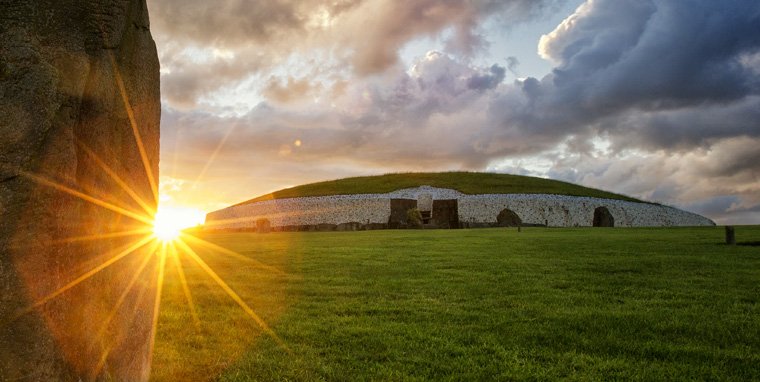Ritual Deposition at Newgrange by Charles Mount
Aspects of Ritual Deposition in the Late Neolithic and Beaker Periods at Newgrange.The passage tomb at Newgrange served as a focus of ceremonial activity in the Late Neolithic and Beaker periods. A complex of monuments was constructed around the mound, consisting of a timber circle or woodhenge to the south-east and a smaller, possibly roofed, timber circle to the west; an enclosing bank constructed along the southern and western sides, and a free-standing circle of great stones encircling the monument. In this paper the view that the faunal and material remains from the Newgrange excavations are domestic refuse is questioned. The deposition and spatial patterning of the faunal material is interpreted as having a ritual significance and the use of this material as representative of the Late Neolithic / Beaker period economy is rejected.
Introduction
The animal remains recovered from the Late Neolithic and Beaker phases of the Newgrange excavations are the only major faunal assemblage known from the Irish Neolithic or Early Bronze Age. This assemblage is of importance for assessing not only the nature of the economy at Newgrange but, by extension, the economy of the Neolithic and Bronze Age periods in Ireland. In recent decades patterns of structured deposition have been recognized at a number of Neolithic monuments (Richards & Thomas 1984, Pollard 1992, 219, Eogan & Roche 1993) in Britain and Ireland. Viewed in this light the Newgrange material provides important information on the ceremonial activities involving a pair of timber circles, and raises important questions about the overall nature of the activities, at the site.The prevailing assumptions regarding the faunal remains were strengthened by van Wijngaarden-Bakker (1974; 1986) who analysed the animal bone from M.J. O'Kelly's excavations. She accepted the excavator's interpretation of the material as the refuse from Beaker squatting and assumed that it was the discard from a domestic settlement. She suggested that the stripping of sods to construct the passage tomb mound had decreased the productivity of arable farming and led to timber circles rather than their economic importance. This paper will argue that a 'domestic' interpretation of the faunal remains does not account for the deposition of the animal remains within the pits and post-holes of the timber circles, the overall large number of pigs at the site or the exceptional aspects of the associated material assemblage and its deposition. Nor does it appear to account for variations in the relative percentage of animal parts found within the faunal material in other areas of the site. This paper is not a definitive statement, a comprehensive re-examination of the excavation record is required for that, but is a review of the published evidence intended to reopen discussion about the nature of the Late Neolithic and Beaker activity at Newgrange.
Charles Mount
Download full article in PDF format
Proceedings of the Prehistoric Society 60, 1994, pp. 433-443

PDF Download - Size 3mb
Proceedings of the Prehistoric Society 60, 1994, pp. 433-443

PDF Download - Size 3mb
Boyne Valley Private Day Tour
 Immerse yourself in the rich heritage and culture of the Boyne Valley with our full-day private tours.
Visit Newgrange World Heritage site, explore the Hill of Slane, where Saint Patrick famously lit the Paschal fire.
Discover the Hill of Tara, the ancient seat of power for the High Kings of Ireland.
Book Now
Immerse yourself in the rich heritage and culture of the Boyne Valley with our full-day private tours.
Visit Newgrange World Heritage site, explore the Hill of Slane, where Saint Patrick famously lit the Paschal fire.
Discover the Hill of Tara, the ancient seat of power for the High Kings of Ireland.
Book Now
Home
| Visitor Centre
| Tours
| Winter Solstice
| Solstice Lottery
| Images
| Local Area
| News
| Knowth
| Dowth
| Articles
| Art
| Books
| Directions
| Accommodation
| Contact

